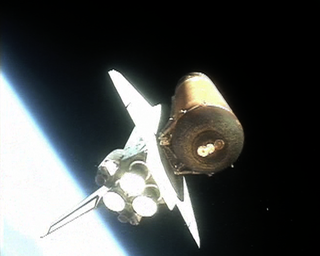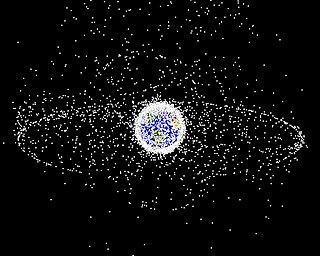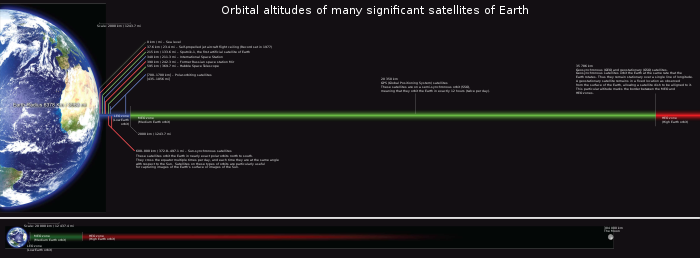
A space elevator, also referred to as a space bridge, star ladder, and orbital lift, is a proposed type of planet-to-space transportation system, often depicted in science fiction. The main component would be a cable anchored to the surface and extending into space. An Earth-based space elevator cannot be constructed with a tall tower supported from below due to its immense weight—instead, it would consist of a cable with one end attached to the surface near the equator and the other end attached to a counterweight in space beyond geostationary orbit. The competing forces of gravity, which is stronger at the lower end, and the upward centrifugal force, which is stronger at the upper end, would result in the cable being held up, under tension, and stationary over a single position on Earth. With the tether deployed, climbers (crawlers) could repeatedly climb up and down the tether by mechanical means, releasing their cargo to and from orbit. The design would permit vehicles to travel directly between a planetary surface, such as the Earth's, and orbit, without the use of large rockets.

A spacecraft is a vehicle that is designed to fly in outer space and operate there. Spacecraft are used for a variety of purposes, including communications, Earth observation, meteorology, navigation, space colonization, planetary exploration, and transportation of humans and cargo. All spacecraft except single-stage-to-orbit vehicles cannot get into space on their own, and require a launch vehicle.

A geosynchronous orbit is an Earth-centered orbit with an orbital period that matches Earth's rotation on its axis, 23 hours, 56 minutes, and 4 seconds. The synchronization of rotation and orbital period means that, for an observer on Earth's surface, an object in geosynchronous orbit returns to exactly the same position in the sky after a period of one sidereal day. Over the course of a day, the object's position in the sky may remain still or trace out a path, typically in a figure-8 form, whose precise characteristics depend on the orbit's inclination and eccentricity. A circular geosynchronous orbit has a constant altitude of 35,786 km (22,236 mi).

A geostationary orbit, also referred to as a geosynchronous equatorial orbit (GEO), is a circular geosynchronous orbit 35,786 km (22,236 mi) in altitude above Earth's equator, 42,164 km (26,199 mi) in radius from Earth's center, and following the direction of Earth's rotation.

A communications satellite is an artificial satellite that relays and amplifies radio telecommunication signals via a transponder; it creates a communication channel between a source transmitter and a receiver at different locations on Earth. Communications satellites are used for television, telephone, radio, internet, and military applications. Many communications satellites are in geostationary orbit 22,236 miles (35,785 km) above the equator, so that the satellite appears stationary at the same point in the sky; therefore the satellite dish antennas of ground stations can be aimed permanently at that spot and do not have to move to track the satellite. Others form satellite constellations in low Earth orbit, where antennas on the ground have to follow the position of the satellites and switch between satellites frequently.

Atmospheric entry is the movement of an object from outer space into and through the gases of an atmosphere of a planet, dwarf planet, or natural satellite. There are two main types of atmospheric entry: uncontrolled entry, such as the entry of astronomical objects, space debris, or bolides; and controlled entry of a spacecraft capable of being navigated or following a predetermined course. Technologies and procedures allowing the controlled atmospheric entry, descent, and landing of spacecraft are collectively termed as EDL.

In astronautics, the Hohmann transfer orbit is an orbital maneuver used to transfer a spacecraft between two orbits of different altitudes around a central body. For example, a Hohmann transfer could be used to raise a satellite's orbit from low Earth orbit to geostationary orbit. In the idealized case, the initial and target orbits are both circular and coplanar. The maneuver is accomplished by placing the craft into an elliptical transfer orbit that is tangential to both the initial and target orbits. The maneuver uses two impulsive engine burns: the first establishes the transfer orbit, and the second adjusts the orbit to match the target.

Space debris are defunct human-made objects in space – principally in Earth orbit – which no longer serve a useful function. These include derelict spacecraft, mission-related debris, and particularly-numerous in-Earth orbit fragmentation debris from the breakup of derelict rocket bodies and spacecraft. In addition to derelict human-made objects left in orbit, space debris includes fragments from disintegration, erosion, or collisions; solidified liquids expelled from spacecraft; unburned particles from solid rocket motors; and even paint flecks. Space debris represents a risk to spacecraft.

A sub-orbital spaceflight is a spaceflight in which the spacecraft reaches outer space, but its trajectory intersects the surface of the gravitating body from which it was launched. Hence, it will not complete one orbital revolution, will not become an artificial satellite nor will it reach escape velocity.
A geocentric orbit, Earth-centered orbit, or Earth orbit involves any object orbiting Earth, such as the Moon or artificial satellites. In 1997, NASA estimated there were approximately 2,465 artificial satellite payloads orbiting Earth and 6,216 pieces of space debris as tracked by the Goddard Space Flight Center. More than 16,291 objects previously launched have undergone orbital decay and entered Earth's atmosphere.

Orbital decay is a gradual decrease of the distance between two orbiting bodies at their closest approach over many orbital periods. These orbiting bodies can be a planet and its satellite, a star and any object orbiting it, or components of any binary system. If left unchecked, the decay eventually results in termination of the orbit when the smaller object strikes the surface of the primary; or for objects where the primary has an atmosphere, the smaller object burns, explodes, or otherwise breaks up in the larger object's atmosphere; or for objects where the primary is a star, ends with incineration by the star's radiation. Collisions of stellar-mass objects are usually accompanied by effects such as gamma-ray bursts and detectable gravitational waves.

An orbital spaceflight is a spaceflight in which a spacecraft is placed on a trajectory where it could remain in space for at least one orbit. To do this around the Earth, it must be on a free trajectory which has an altitude at perigee around 80 kilometers (50 mi); this is the boundary of space as defined by NASA, the US Air Force and the FAA. To remain in orbit at this altitude requires an orbital speed of ~7.8 km/s. Orbital speed is slower for higher orbits, but attaining them requires greater delta-v. The Fédération Aéronautique Internationale has established the Kármán line at an altitude of 100 km (62 mi) as a working definition for the boundary between aeronautics and astronautics. This is used because at an altitude of about 100 km (62 mi), as Theodore von Kármán calculated, a vehicle would have to travel faster than orbital velocity to derive sufficient aerodynamic lift from the atmosphere to support itself.

In astrodynamics and aerospace, a delta-v budget is an estimate of the total change in velocity (delta-v) required for a space mission. It is calculated as the sum of the delta-v required to perform each propulsive maneuver needed during the mission. As input to the Tsiolkovsky rocket equation, it determines how much propellant is required for a vehicle of given empty mass and propulsion system.

Space launch is the earliest part of a flight that reaches space. Space launch involves liftoff, when a rocket or other space launch vehicle leaves the ground, floating ship or midair aircraft at the start of a flight. Liftoff is of two main types: rocket launch, and non-rocket spacelaunch.

The Kessler syndrome, proposed by NASA scientist Donald J. Kessler in 1978, is a scenario in which the density of objects in low Earth orbit (LEO) due to space pollution is numerous enough that collisions between objects could cause a cascade in which each collision generates space debris that increases the likelihood of further collisions. In 2009, Kessler wrote that modeling results had concluded that the debris environment was already unstable, "such that any attempt to achieve a growth-free small debris environment by eliminating sources of past debris will likely fail because fragments from future collisions will be generated faster than atmospheric drag will remove them". One implication is that the distribution of debris in orbit could render space activities and the use of satellites in specific orbital ranges difficult for many generations.

A medium Earth orbit (MEO) is an Earth-centered orbit with an altitude above a low Earth orbit (LEO) and below a high Earth orbit (HEO) – between 2,000 and 35,786 km above sea level.
Spacecraft collision avoidance is the implementation and study of processes minimizing the chance of orbiting spacecraft inadvertently colliding with other orbiting objects. The most common subject of spacecraft collision avoidance research and development is for human-made satellites in geocentric orbits. The subject includes procedures designed to prevent the accumulation of space debris in orbit, analytical methods for predicting likely collisions, and avoidance procedures to maneuver offending spacecraft away from danger.

2020 SO is a near-Earth object identified to be the Centaur upper stage used on 20 September 1966 to launch the Surveyor 2 spacecraft. The object was discovered by the Pan-STARRS 1 survey at the Haleakala Observatory on 17 September 2020. It was initially suspected to be an artificial object due to its low velocity relative to Earth and later on the noticeable effects of solar radiation pressure on its orbit. Spectroscopic observations by NASA's Infrared Telescope Facility in December 2020 found that the object's spectrum is similar to that of stainless steel, confirming the object's artificial nature. Following the object's confirmation as space debris, the object was removed from the Minor Planet Center's database on 19 February 2021.
Very low Earth orbit is a range of orbital altitudes below 400 km (250 mi), and is of increasing commercial importance in a variety of scenarios and for multiple applications, in both private and government satellite operations. Applications include earth observation, radar, infrared, weather, telecommunications, and rural internet access among others.
















